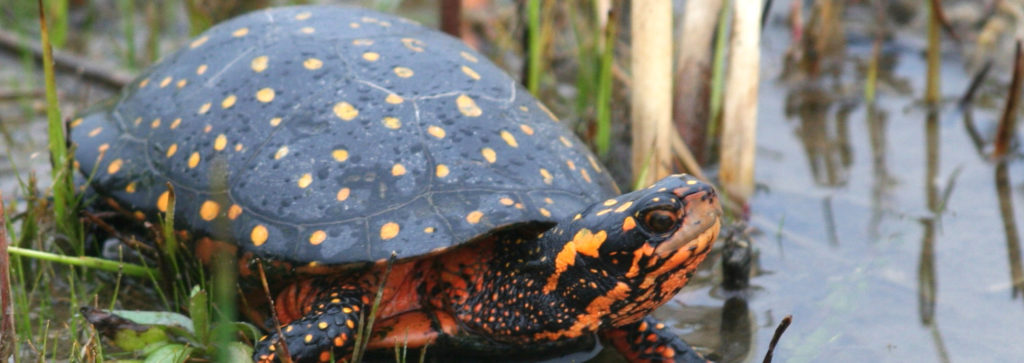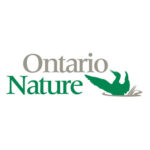Ontario Nature Blog
Receive email alerts about breaking conservation
and environmental news.
© Lora Denis
Gray ratsnake © Amelia Argue
Ontario’s reptiles and amphibians are protected under the federal Species at Risk Act and these provincial acts:
These laws, as well as how they protect species and their habitats, are described below.
1. Canadian Species at Risk Act, 2002 (SARA)
The Committee on the Status of Endangered Wildlife Canada (COSEWIC) assesses the status of Canada’s wildlife species, and makes recommendations to the federal Minister of the Environment as to which species should be placed on Schedule 1 (the list of wildlife species at risk in Canada) of the SARA 2002, and what their status should be. COSEWIC is a group of experts who have considerable expertise in wildlife biology and management, as well as Aboriginal Traditional Knowledge. Its members are federal and provincial government employees, nongovernment scientists and species experts.
A major limitation of this act is that the Minister can choose not to add a species to Schedule 1 for economic or social reasons. As a result, a species that COSEWIC determines to be at risk on the basis of the best available science may not be placed on Schedule 1 and will not receive any legal status or protection.
The SARA 2002 protects individuals of Threatened, Endangered and Extirpated species (even though a species is considered to be extirpated, it might still exist) and, under the act, killing, harming or harassing individuals or removing them from the wild is illegal:
No person shall kill, harm, harass, capture or take an individual of a wildlife species that is listed as an extirpated species, an endangered species or a threatened species. (Section 32[1])
No person shall possess, collect, buy, sell or trade an individual of a wildlife species that is listed as an extirpated species, an endangered species or a threatened species, or any part or derivative of such an individual. (Section 32[2])
The SARA 2002 also protects the “residence” and the critical habitat of Threatened, Endangered and Extirpated Species on federal lands:
No person shall damage or destroy the residence of one or more individuals of a wildlife species that is listed as an endangered species or a threatened species, or that is listed as an extirpated species if a recovery strategy has recommended the reintroduction of the species into the wild in Canada. (Section 33)
Subject to this section, no person shall destroy any part of the critical habitat of any listed endangered species or of any listed threatened species – or of any listed extirpated species if a recovery strategy has recommended the reintroduction of the species into the wild in Canada – if (a) the critical habitat is on federal land, in the exclusive economic zone of Canada or on the continental shelf of Canada … (Section 58[1])
The habitat protection provided under the SARA 2002 applies only to federal lands, which make up a very small proportion of the land area of Ontario. Critical habitat is protected for a Threatened or Endangered species only once it has been identified in a species’ recovery strategy.
Penalties for offences under this act can be a fine of up to $1,000,000 for corporations and a fine of up to $250,000 and/or imprisonment for up to five years for an individual.

2. Ontario Endangered Species Act, 2007 (ESA)
This updated act is a significant improvement over the previous Ontario Endangered Species Act in a number of ways. For example, the previous act offered legal protection only to Endangered species, whereas the ESA 2007 also offers legal protection to Threatened species. Additionally, unlike the 2007 act, the previous act provided no habitat protection to listed species.
The Committee on the Status of Species at Risk in Ontario (COSSARO) is composed of up to 11 government and nongovernment members with scientific expertise and Aboriginal Traditional Knowledge. The committee has been assessing the status of Ontario’s wild species since 1995 and was legally recognized under the ESA 2007. COSSARO makes species assessments using the best available scientific information and Aboriginal Traditional Knowledge. Unlike COSEWIC’s recommendations, which the federal Minister of the Environment can refuse for economic or political reasons, species that COSSARO designates as “at risk” are automatically placed on the Species at Risk in Ontario list.
The ESA 2007 protects individuals of Threatened, Endangered and Extirpated species and, under the act, killing, harming or harassing individuals or removing them from the wild is illegal:
No person shall, kill, harm, harass, capture or take a living member of a species that is listed on the Species at Risk in Ontario List as an extirpated, endangered or threatened species. (Section 9[1][a])
No person shall possess, transport, collect, buy, sell, lease, trade or offer to buy, sell, lease or trade, (i) a living or dead member of a species that is listed on the Species at Risk in Ontario List as an extirpated, endangered or threatened species, (ii) any part of a living or dead member of a species referred to in subclause (i), (iii) anything derived from a living or dead member of a species referred to in subclause (i) … (Section 9[1][b])
This act also protects the habitat of Threatened, Endangered and Extirpated species on all Crown and private land in Ontario:
“No person shall damage or destroy the habitat of a species that is listed on the Species at Risk in Ontario List as an endangered or threatened species; or a species that is listed on the Species at Risk in Ontario List as an extirpated species, if the species is prescribed by the regulations for the purpose of this clause. (Section 10[1][a and b])
The 42 species that were regulated under the previous Ontario endangered species legislation and any species that are newly listed under the ESA 2007 automatically receive general habitat protection. General habitat includes any areas that a species currently depends on, and general habitat protection for a particular species remains in place until regulated habitat is defined for that species in a species-specific habitat regulation. The species-specific habitat regulation provides a more detailed description of the habitat a species uses and is the legal description of that habitat.
Along with the 42 previously regulated species, an additional 86 species were also listed as Endangered or Threatened under the previous Species at Risk in Ontario list, but these species were not regulated and received no legal protection under the old ESA. They are now on the Species at Risk in Ontario list under the ESA 2007, yet they do not automatically receive the general habitat protection and their habitat will not be protected until June 30, 2013 (or earlier if a species-specific habitat regulation is created). It is incongruous that a species identified as Threatened 10 years ago does not receive habitat protection, but a species identified as Threatened after the ESA 2007 came into effect automatically receives habitat protection; from a scientific perspective, both species should be protected. In any case, the result is that the ESA 2007 does not currently protect habitat for many of the species listed as Endangered and Threatened. This is a major flaw in the act’s protection of habitat. For example, the eastern massasauga and Blanding’s turtle (both listed as Threatened) currently receive no habitat protection under this act.
Another major concern that has been raised about the habitat protection this act provides is that it can be circumvented by permits that allow individuals (such as developers, and representatives of government and other industry) to destroy the habitat of species at risk if “the Minister is of the opinion that the activity will result in a significant social or economic benefit to Ontario.” Unfortunately, this means that habitat of species at risk is not truly protected from development, since many large development projects, for example, major highways, could be considered to be “of social or economic benefit to Ontario.”
Penalties for first offences under the ESA 2007 can be a fine of up to $1,000,000 for corporations and a fine of up to $250,000 and/or imprisonment for up to one year for an individual.
3. Ontario Provincial Policy Statement issued under the Ontario Planning Act
The Provincial Policy Statement protects the habitat of threatened and endangered species by prohibiting development and site alteration in significant habitat of endangered and threatened species (Section 2.1.3[a]).
This policy also prohibits development and site alteration in “significant wildlife habitat” (Section 2.1.4[d]).
Section 6 of the policy states that “significant” as it applies to areas means those that are “ecologically important in terms of features, functions, representation or amount, and contributing to the quality and diversity of an identifiable geographic area or natural heritage system.” In the same section, “wildlife habitat” is defined as “areas where plants, animals and other organisms live, and find adequate amounts of food, water, shelter and space needed to sustain their populations. Specific wildlife habitats of concern may include areas where species concentrate at a vulnerable point in their annual or life cycle; and areas which are important to migratory or non-migratory species.”
It is important to note, however, that “development” is defined in Section 6 of the Provincial Policy Statement as “the creation of a new lot, a change in land use, or the construction of buildings and structures, requiring approval under the Planning Act.” Significant wildlife habitat and the habitat of Threatened and Endangered species are not protected from any work under the Drainage Act, mining and mining exploration, or creation or maintenance of infrastructure (which includes roads).
4. Ontario Fish and Wildlife Conservation Act
The Fish and Wildlife Act prohibits hunting (killing, capturing, injuring and harassing) and trapping of “specially protected wildlife” (Section 5[1]). Hunting also includes lying in wait for, searching for, being on the trail of, pursuing, chasing and shooting at wildlife with the intent to kill it.
Specially protected wildlife includes specially protected reptiles and specially protected amphibians, which are listed in Schedules 9 and 10 of the act, respectively.

Gananoque Lake Nature Reserve © Smera Sukumar